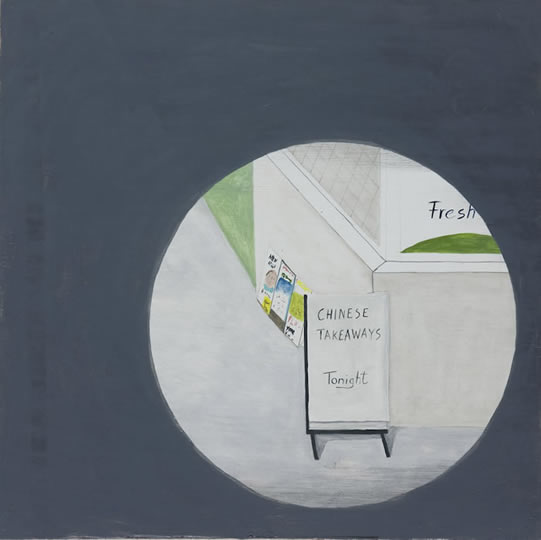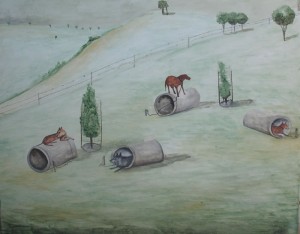Isobel Philip uncovers the layers of Noel McKenna’s mischievous wit…
Noel McKenna’s work always makes me smile. It is a smile partially triggered by his dry and roguish wit, but more than that, it is a smile brought on by something else – something beneath the filmy, semi-transparent surface of his small paintings. His gently awkward scenes savour a second glance. In passing they read as vignettes of quirky, slightly skewed, realism, but given more time – if you strike up an intimate little conversation with them – they begin to reveal their secrets. There is more to a McKenna than first meets the eye.
And so it is with a more perceptive frame of mind that one should approach the few McKenna works included in the group show at Darren Knight Gallery. The paintings work successfully as a series, with each work in dialogue with its neighbor. Yet they are equally as beguiling when taken individually.
Oil on plywood, 40x40cm.
In Chinese Takeaways Tonight McKenna’s wry aesthetic deftly struts its stuff. Through a peephole we see the corner of a building and the sign that bears the (delightfully) grammatically incorrect slogan of the work’s title. By announcing this scene through a literal peephole, McKenna dramatizes the quiet voyeurism that informs all his work. The objects of McKenna’s voyeuristic tendencies, however, are commonly ignored; the magical moments embedded within the commonplace and the mundane.
Yet, while his scenes portray commonplace subjects, the very fact that these subjects have been selected memorializes them, allowing them to exist beyond the ‘everyday’. Instead, they inhabit a world defined by McKenna’s subtly distorting realism and skewed perspective. His lines and angles are all slightly ‘off’, but as such they assume individual character traits – they are mischievous lines.
I think this is the way I’ve always dealt with McKenna’s work, as if each painting were occupied by an assortment of little personalities.
Oil on plywood, 60x60cm.
As far as McKenna’s abstract and inanimate portraiture goes, I’ve always felt that his trees have the strongest personalities – they can be fragile, proud, cruel, sullen or graceful. His trees can be social, locked in intimate embraces, or painfully lonely. And while none of the paintings included in the show are really ‘tree-centric’, the one thought that lingered long after I had left the gallery concerned the plight of the trees in Working dogs, Upper Hunter. In the foreground, in a space contained by a barbed wire fence, there are two trees, separated from one another, each encased in a wire cage. In the background, on a hill beyond the fence, three trees huddle – their leaves fused into a single canopy. I felt so sorry for those caged trees, I could almost hear them quietly weeping. Why couldn’t they go and join the others?
Those trees stayed with me (as did the smile). For all his shrewd and calculated wit, McKenna’s ability to coax emotion from an inanimate object or a line – his ability to make trees cry – is truly remarkable.


